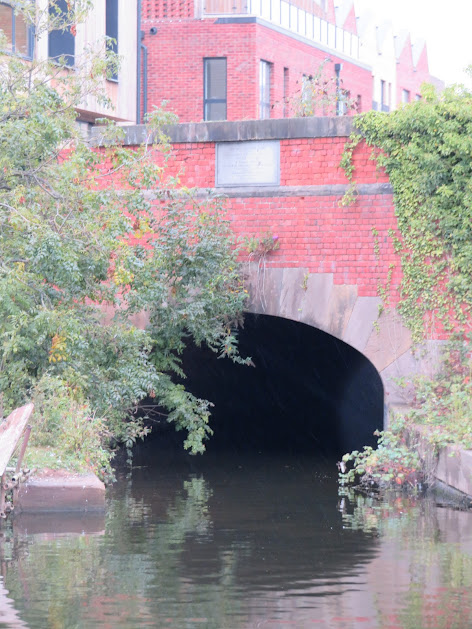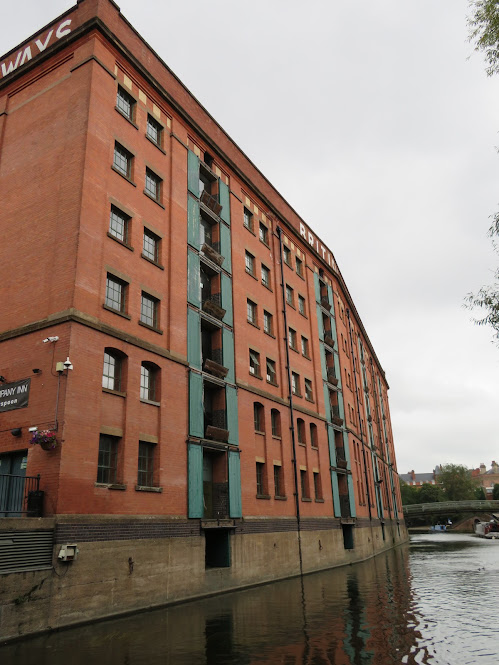There had been a bit of rain through the night but not heavy enough to wake us up with the noise on the roof. It had stopped by the time we got underway for the trip into Nottingham. A bit of a grey day that means the pictures are a bit grey, but made up for with the number of them today.
As Colwick Country Park morphed into the outskirts of the city it looked like there was a canal arm off the river, but no it was the Beck Valley Storm Water Culvert that was built in 1884. An early attempt at stopping Nottingham flooding no doubt.
Next, again on the north bank after a load of apartments, is another water 'feature'. I had my doubts that this was industrial and was built to go with the new buildings. But no, it was built as a river/rail transhipment basin with track down both sides and many warehouses too. However it seems to have been created for the war effort as it wasn't there on 1938 maps, but it was on 1953 ones.
We passed under Lady Bay Bridge and between Environment Agency and Nottingham Forest's ground on the south bank is this, the entrance to the Grantham Canal. It was opened in 1797 and had 18 wide locks to take it to Grantham. However it was closed in 1936, but there had to be a water level of 2ft maintained in it for agriculture. This has meant that the canal is still there just the locks, bridges etc and the Grantham Canal Society have accepted the challenge of reopening it.
We passed the entrance to the Nottingham Canal at Meadow Lane Lock to have a look up the river a little. That took us past the Nottingham Forest Ground that is one of the select grounds near a navigation.
This is a bit of detail of Trent Bridge, a sandstone and iron bridge that was built between 1868 and 1871. The first bridge was thought to have built in 920. It was replaced in 1156 and 1551 when it was known as Hethbeth Bridge. It was damaged several times over the years by floods and hence the new bridge that is there today.
We landed on the pontoon up river of Meadow Lane Lock as they are working on the down river, and the one with the better approach. I went up to help Helen with the lock. There is only one paddle working on the bottom gates but the paired paddles on one upper gate were leaking extremely badly as they weren't coordinated. One was still open when the other was fully closed. It took all our might to get it open.
It seems that the guy who moored his wide beam in the look and let the water out so he could check out the boats base plate!!!!??? didn't do too much damage. Both ladders are new but other wise the north wall seems intact and you can see the extent of the damage with the new pointing on the south wall. We stopped for water just after the lock.
This is one of the original canal bridges that is from 1793 when the first couple of miles was opened, from Meadow Lane Lock to the city centre. The fulllength to Langley Mill on the Erewash Canal opened in 1796.
The Fellows, Morton and Clayton warehouse was built in 1895 as a covered warehouse with berths for two boats inside. It later opened as a Canal Museum and Heritage Centre but was later converted to a pub that was closed for a while, but is now open again.
A little further on is the British Waterways Warehouse. It is a massive building and was built in 1919 and the place must have been extremely busy at its peak. We then passed up Castle Lock and found a mooring near to Castle Marina. Just after we moored it started to rain heavily, great timing or what! We popped to Sainsbury's for a few bits before lunch when the rain stopped, and then headed into town.
Helen had found a bit of a walk on line so we headed off to see something we had missed previously, The Park Tunnel. The 1st Duke of Newcastle had a hunting ground close to the city. By the time of the 4th Duke he wished to convert it to a residential estate. Unfortunately it had very poor access. He decided to build a tunnel that was big enough for a carriage and horses.
Unfortunately it was a big failure as the gradient up to Derby Road was far too great for the horses to pull the carriage up!
The walk up from the bottom to the upper street level is steep. The Park Estate are trying to get this tunnel road closed as a public right of way as it is far too posh a place to allow the riff raff in.
At the end of a street full of white stuccoed houses with great views and massive price tags is this house designed by the City's architect Fothergill and Hines. The signature is turrets and bands of red and blue bricks. Once you know that you can see his buildings all over the city.
Just down the hill is a tablet in the road that marks the spot where King Charles I raised his standard to try and attract support for his cause in August 1642. The spot was on a hill north of the castle gatehouse called Derry Mount. Few did come forward so he gave up and headed for Salisbury leaving the castle and Nottingham to the Parliamentarians, at least for the time being.
We loved this building, while not a Fothergill designed building it is very tied to Nottingham. It was the flagship store for Boots the Chemist. The company was started by John Boot who was an agricultural labourer, but through ill health he had to set up as a herbalist. His wife helped him and when he died his son Jessie took over and developed the business. Jessie designed the building that was replaced and had been built in 1892. The architect of this building was Albert Nelson Bromley, a Scot practicing in Nottingham. It was built between 1902 and 1905. It was further extended in the 1920's and 30's. I love the Art Noveau windows and the brick work. There is so much detail in it you could spend hours looking it over.
There is so much to see in Nottingham if you look up. There are plenty of different styles of buildings and the shopping centre seems to have been demolished. I wonder what they will end up doing with it now.
















No comments:
Post a Comment